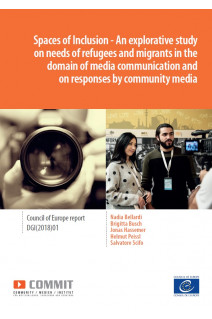The role played by media in framing the public debate on migration, with often divisive narratives focussing on the threats that refugees and migrants can pose to the security, welfare and cultures of European societies, has attracted much attention in political and academic circles. While it is essential to properly equip and prepare journalists for the challenging task of contextualised and evidence-based reporting on this complex topic, it is equally vital to ensure that sufficient opportunities are provided to migrants themselves to develop an independent voice.
This report explores the media habits and particular needs of refugees and migrants in the domain of media communication. Good practice examples show how community media can meet the communicative needs of refugees and migrants by offering training and space for self-representation, and by offering points of entry into local networks. Their bottom-up approach to content production contributes to a multilingual media environment that reflects the diversity of European societies and recognises marginalised communities as integral and respected part of the audience.
Introduction
Section I: Community Media in Europe – an overview
Section II: Study based on interviews with refugees
Section III: The right to have a voice – portraits of community media productions by migrants and refugees
Executive summary and recommendations
Bibliography




